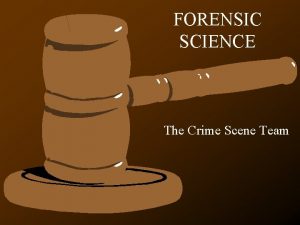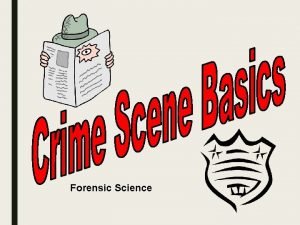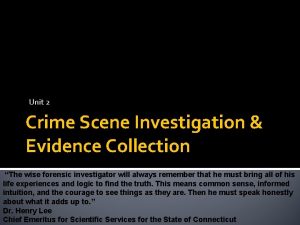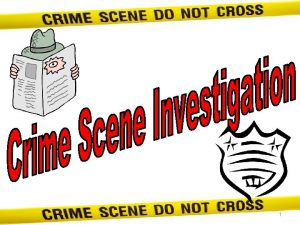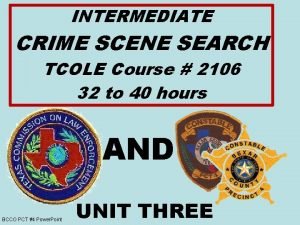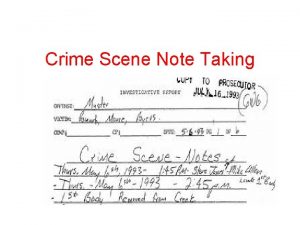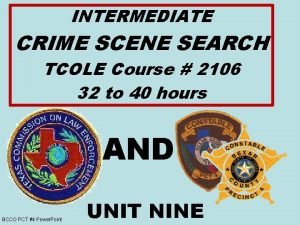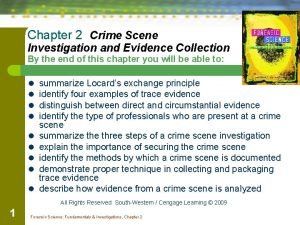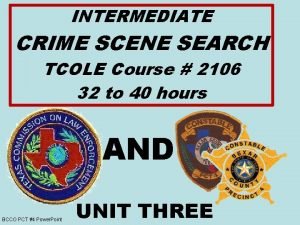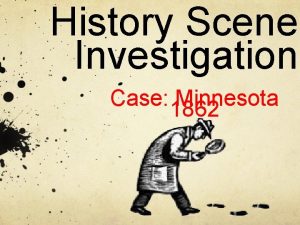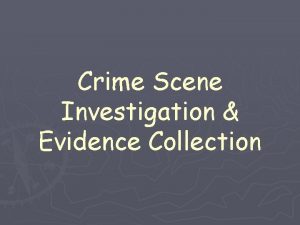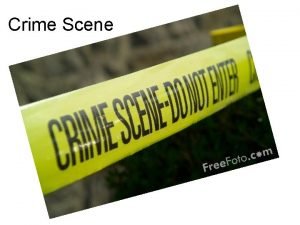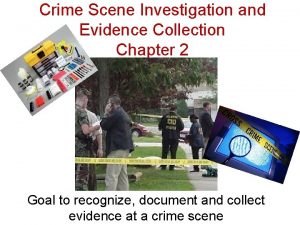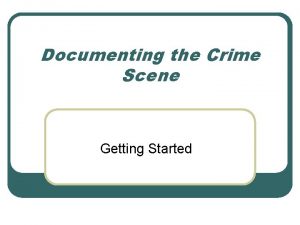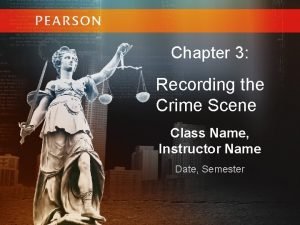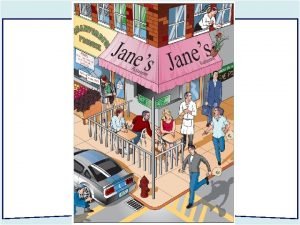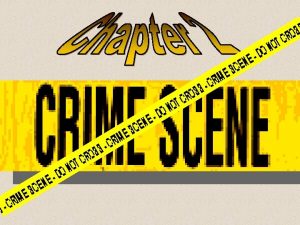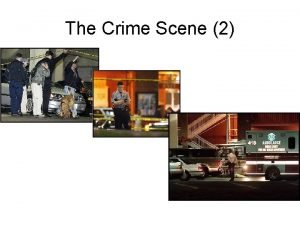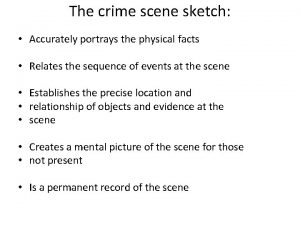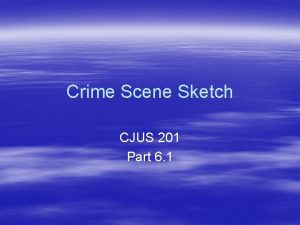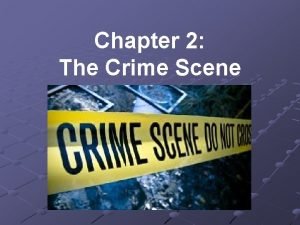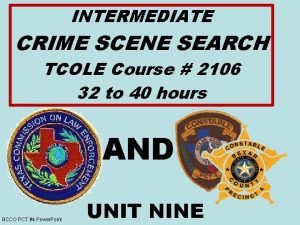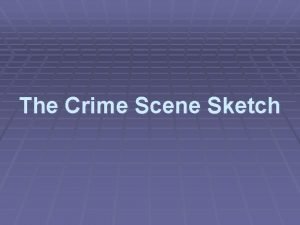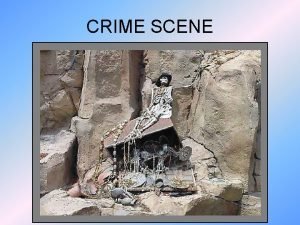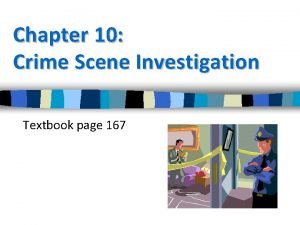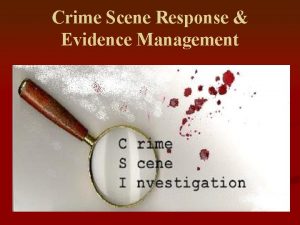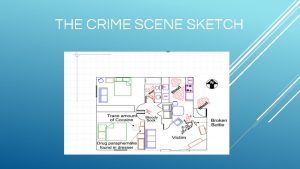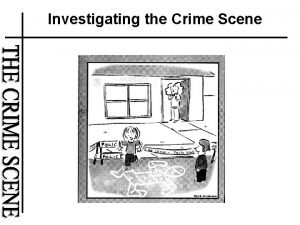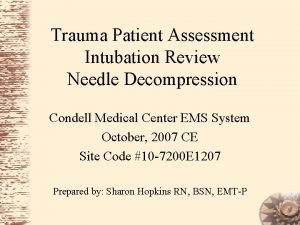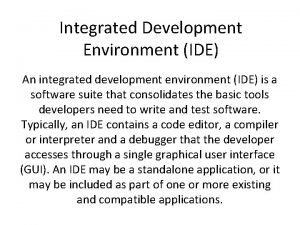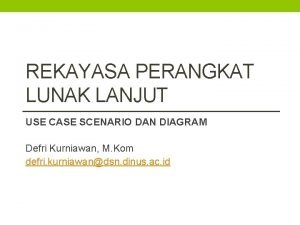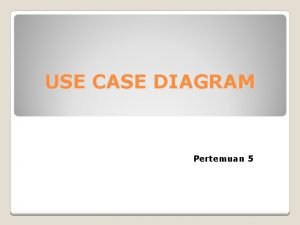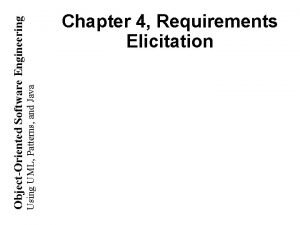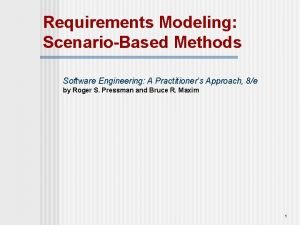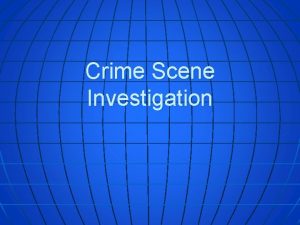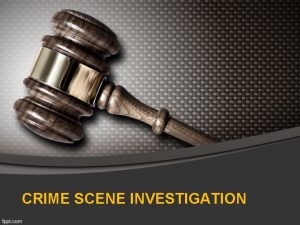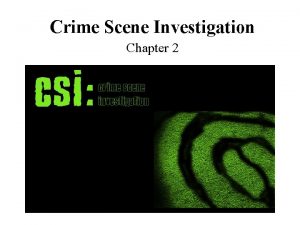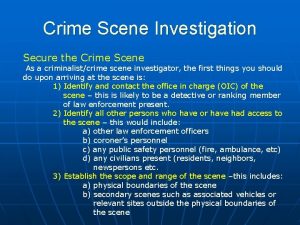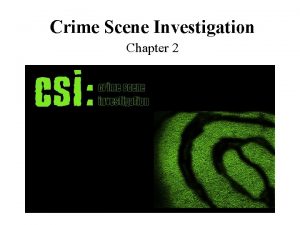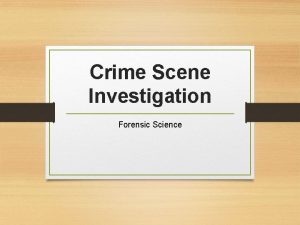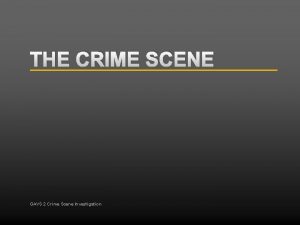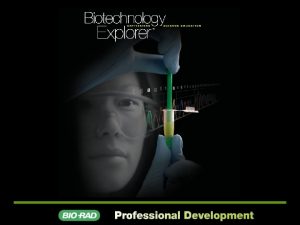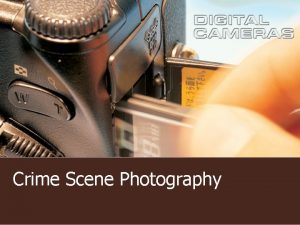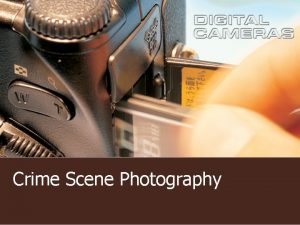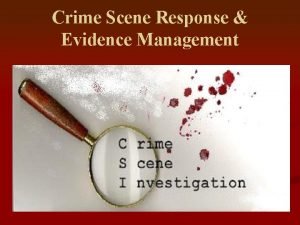Crime Scene Investigation 1 Crime Scene Investigation Scenario



































































































- Slides: 99

Crime Scene Investigation 1

Crime Scene Investigation Scenario • Police have been called to a one-room apartment to investigate a possible homicide. The body is on the floor near the center of the room with what appears to be a single gunshot to the head. The suspected weapon is lying nearby. • Describe how you would go about investigating this scene, with particular reference to establishing the integrity of the crime scene, safety and contamination of any evidence. 2

Crime Scene Investigation Principles of Crime Scene Investigation • Preserving the Integrity of the Crime Scene • Recording the Crime Scene • Searching the Scene • Collecting & Packaging of Evidence • Crime Scene Safety The most important aspects of CSI work include: Securing the scene Prevention of contamination Preservation of physical evidence 3

Crime Scene Investigation The Crime Scene Environment Crime Scene Investigators (CSIs) interact with: • Police officers (including general duties, investigative, specialist and administrative areas Some CSIs are police officers/some are civilian) • The judicial system including: legal practitioner, (prosecution and defense lawyers) judges and courts (including civil, coronial, criminal and appeal Courts) • Forensic scientists (including specialist laboratories and experts) 4

Crime Scene Investigation • Forensic medical practitioners (including pathologists, psychologists and psychiatrists) • General community often represented through juries, including those involved in specific incidents (victims, suspects, witnesses) and expectations shaped by media reporting of actual cases, fictional material, (books, magazines, television and movies). 5

Crime Scene Investigation Role of the Crime Scene Investigator • Establish clear and direct lines of communication and be effective managers: • At the scene of the crime or incident • Of the processing of physical evidence collected from the scene • Of the investigative process as it relates to physical evidence • Of the final presentation of physical evidence at court 6

Crime Scene Investigation When investigating, the CSI should consider: • Use an entry other than that taken by the suspect • Establish the path taken by other persons first on the scene • Consider the loss of trace evidence on entry throughout your examination, (e. g. . shoe/foot impressions on the floor) 7

Crime Scene Investigation • Reassess Occupational Safety and Health (OSHA) issues • Establish the extent of the scene and additional assistance that may be required • Establish an entry and exit path for the Senior Investigating Officer and specialists to access the scene, if necessary 8

Crime Scene Investigation Boundaries usually start at the focal point of the scene and extend outward to include: • Where the crime occurred • Potential points of entry and exit of suspects and witnesses • Places where the victim or evidence may have been moved 9

Crime Scene Investigation The basic protocol for scene processing can be summarized as several sequenced tasks: 1. 2. 3. 4. Survey the crime scene Photograph the crime scene Map and measuring the crime scene Record and document the location of physical evidence at the crime scene 5. Searching for fingerprints and other physical evidence. *During the walk-through, a walkway other than the established path of entry should be used to reduce contamination. 10

Crime Scene Investigation There are generally 6 important categories of documentation that are applicable to any search: Administrative Worksheet Narrative Description Photographic Log – overview, specifics Diagram/Sketch – scaled sketch Evidence Recovery Log - Identify, Collect and Preserve evidence • Latent Print Lift Log • • • 11

Crime Scene Investigation Approach to Searching • Consider the nature of physical evidence and the principles of exchange and transfer. (Locard) • Each scene is unique and must be approached with an open mind. 12

Crime Scene Investigation • The most transient evidence should always be collected first, progressing to the least transient evidence. • Moving from the least intrusive collection techniques to the most intrusive techniques. 13

Crime Scene Investigation • The collection of evidence must be documented, by recording its location at the scene, the date of collection and who collected it. • For each item collected, a chain of custody must be established. 14

Crime Scene Investigation List of evidence collection guidelines for: • Bloodstains • Firearms evidence • Seminal stains • Tool marks • Hair • Controlled substances & medicinal preparations • Fibers • Questioned documents • Glass • Latent fingerprints • Paint • Flammable liquids 15

Crime Scene Investigation 3 Methods to adopt in your approach to searching • Positive Approach – what is there • Negative Approach – what isn’t there • Information/Intelligence 16

Crime Scene Investigation • The positive search which centers on known facts to locate evidence which is expected to be found (the tool mark in the scenario) • The negative search, which centers on known facts to indicate that no evidence, was found to indicate an alternate explanation (e. g. could the suspect have entered through another door) 17

Crime Scene Investigation • The intelligent search which requires a combination of known facts, consideration for other explanations and a systematic and thorough approach to locate any other evidence (finding of the tip of the pliers, based on information about a pair of pliers) 18

Crime Scene Investigation Searching Patterns or Methods • There are 5 basic methods that are universally accepted. These are: – Line/Strip method – Spiral method – Wheel/Ray method – Grid method – Quadrant/Zone method 19

Crime Scene Investigation 20

Crime Scene Investigation • Line/Strip Search Pattern --One or two investigators start at the boundary of the crime scene and search in straight lines across to the other side of the crime scene. • Grid Search Pattern -- Two or more investigators form a grid by searching in line patterns that overlap and are perpendicular to each other. 21

Crime Scene Investigation • Spiral Search Pattern --One investigators searches in a spiral path from the center of the crime scene to the boundary (outward) or from the boundary of the crime scene to the center (inward). • Wheel/Ray Search Pattern --Several investigators search in straight lines from the center to the boundary (outward) or from the boundary to the center (inward). • Quadrant/Zone Search Pattern --The crime scene is divided into smaller sections (zones). One or more investigators are assigned to search each zone. 22

Crime Scene Investigation The area(s) to be searched will often be determined by the: • Nature of the incident • Nature of the physical evidence present • Location • Terrain • Established facts 23

Crime Scene Investigation The Golden Rules of a Search 3 Golden Rules to maximize the recovery of evidence: 1. Search areas should be determined to maximize concentration. Each area should take no more than 20 -40 minutes to search. 2. Breaks should be taken after each search. (At least 10 minutes) 3. Search the same area twice so that nothing is overlooked 24

Crime Scene Investigation Legal Considerations Regarding Evidence Circumstances where the police can search for evidence in the absence of a search warrant: 1. Emergency circumstances 2. To prevent loss or destruction of evidence 3. A search of a person and property in immediate control of the person as long as it is in the event of a lawful arrest 4. A search made under consent of the party 25 involved

Crime Scene Investigation Purpose of an CSI examination is to: 1. Locate and identify potential evidence 2. Provide information about the crime or incident 3. Assist in the corroboration or otherwise of information provided by suspects, victims or witnesses 26

Crime Scene Investigation Type and Scale of Examination Determined by: 1. Seriousness of the offence/incident, type of the offence/incident and relevant circumstances 2. The nature of the scene 27

Crime Scene Investigation Before examining evidence, which involves moving, or disturbing it, the following should be checked: 1. Ensure appropriate OSHA requirements been followed (e. g. bio hazards procedures) 2. Has the area or item to be examined been photographed in place? 3. Ensure adequate notes, sketches and measurements of the area or item have been taken? 4. If the area or item is to be moved or disturbed during the examination, ensure that evidence will not be contaminated or destroyed? 28

Crime Scene Investigation Prioritize the collection of evidence to prevent loss of, or damage to, an item. Smaller items or evidence are usually prone to damage. Generally: 1. Ensure fragile evidence is collected first e. g. latent fingerprints 2. Then collect trace evidence e. g. blood and fiber 3. Finally, collect larger items 29

Crime Scene Investigation Cross Contamination and Biological Degradation • Prevent cross contamination and/or biological degradation. When collecting an item from the scene care must be taken to ensure that it is collected in a way, which will preserve (as closely as possible) its original condition. 30

Crime Scene Investigation Labeling At the time of collection: - a detailed label should be attached to the package and include all of the following: • • • Time & date collected By whom collected Type of incident Description of the item Location of the incident Suspect & victims name if known Location of the item Name of the Senior CSI & their location CSIs – names and job number 31

Crime Scene Investigation Continuity is maintained by: • Accurate records (of the scene and item) • Detailed labeling, appropriate and sealed packaging • Accurate official records and logs • Secure storage of the item(s) • Full documentation of any subsequent movement • It is preferable that the CSI is the only link in the chain of custody of an item 32

Crime Scene Investigation Interpretation may include: • Assist in establishing how the incident occurred • Prove or disprove witness, suspect or victims, versions of the incident • Provide investigators with information, which may assist with inquiries and interviewing of witnesses, victims, and suspects 33

Crime Scene Investigation Suitable evidence is used in court. Interpretation may suggest a theory of what occurred, based on: • Observations at the crime or incident scene • The physical evidence located • Information received from the Senior Investigating Officer e. g. interviews and subsequent inquiries • Results of examinations, analyses and other specialized tests. 34

Crime Scene Investigation • The results of interpretation are the formation of opinions or likely conclusions • Interpretation must be thorough and a reliable report made of the observations, rather than the investigator's belief of what occurred. 35

Crime Scene Investigation 4 Basic Limitations to the process of Reconstructing the incident: 1. Quantity and quality of the information received, physical evidence present and method of recording. 2. Ability and expertise of the crime scene investigator. 3. Extent of interpretation required. 4. Time and financial resources available. 36

Crime Scene Investigation Human Remains and Identification Notes should include: • Position of the body • Description and state of clothing (is it partially removed, stained, tangled or twisted? ) • Describe the location, intensity, size, and direction of flow of any staining if possible. • Type of stain (blood-like, semen, dirt, vomit, feces, urine or some other fluid) 37

Crime Scene Investigation • Any visible damage to the clothing and body • Description of bloodstains (spots, spatter or smearing and directionality) • Appearance of evidence removal (has the body been washed or blood cleaned from the body? ) • Estimated amounts of blood (has staining penetrated layers, carpeting or other surfaces, is it superficial? ) 38

Crime Scene Investigation The Recovery Of Human Remains 1. Outdoor vs. Indoor 2. Decomposition Rates/Temp. 3. Use of Dogs to find bodies (9/11) 39

Crime Scene Investigation Forensic Specialties Anthropology • The scientific discipline mainly concerned with the study of bodily or skeletal remains. • DNA, Mitochondrial DNA (family) • Dr. Michael Baden/[ ] 40

Crime Scene Investigation Its possible to determine 2 types of information from remains: 1. Physical characteristics such as sex, ethnicity, approximate age, stature, certain disease states and old injuries 2. The actual identification of the individual 41

Crime Scene Investigation Forensic Odontology • Uses dental records to help in human identification, and is often necessary for the identification of unrecognizable bodies, after fires or mass disasters, and in the identification and comparison of bite marks. 42

Crime Scene Investigation Forensic Pathology Estimating Time of Death 1. Changes in appearance of eyes 2. Cooling of Body Temperature (livor mortis) 3. Rigidity of the body (rigor mortis) 4. Blood pooling in a specific area of the body (algor mortis) 5. Decomposition or putrefaction is the breakdown of the body due to autolysis and bacterial decomposition 6. Insect Infestation and Forensic Entomology 43

Crime Scene Investigation Forensic Photography • Crime scene photographs are permanent and comprehensive pieces of evidence that may be presented in court to prove or disprove facts in question. 44

Crime Scene Investigation Blood Splatter Analysis -Bloodstain Interpretation • Properly collected and preserved blood evidence can establish a link between an individual, a criminal act or a crime scene • It is used to strengthen or contradict a witness or suspects statement or to eliminate a person as a potential suspect in a crime. 45

Crime Scene Investigation Blood Splatter Analysis Expert • 1971 • Mac. Donell (AFIP, Washington, DC) 1. Outlined general rules regarding blood spatter evidence 2. Outlined general rules of blood spattern recognition including spot shape, edge characteristics, spot diameter, angle of impact, degree of spatter, directionality, cast off droplets and high and low velocity impact stains 46

Crime Scene Investigation Collecting Blood Evidence • Collection and Preservation of Blood Evidence 1. Dried Bloodstains 2. Wet Bloodstains • http: //www. crime-sceneinvestigator. net/blood. html 47

Crime Scene Investigation Wet Blood Stains • Liquid pools - pick up on gauze pad or other clean, sterile cotton cloth. Allowed to air dry thoroughly at room temp. Refrigerate or freeze as soon as possible. Delays beyond 48 hours may make blood samples useless. • Deliver stained object immediately to lab. • If the object must be mailed, allow the stain to air dry completely before packaging. • Do not heat stained material or place it in bright sunlight to dry. Hang clothing and similar articles in a room where there is adequate ventilation. • If not completely dry, label and roll in paper or place in a brown paper bag or box and seal and label container. Place only one item in each container. Do not use plastic containers. 48

Crime Scene Investigation Dried Blood Stains • On clothing, wrap the item in clean paper, place the article in a brown paper bag or box and seal and label container. • Small solid objects: send the whole stained object to the Lab. • Large solid objects: cover the stained area with clean paper and seal the edges down with tape to prevent loss or contamination. If impractical to deliver the whole object to the Lab, scrape the stain onto a clean piece of paper, which can be folded and placed in an envelope. Scrape blood from objects using a freshly washed and dried knife or similar tool. Wash and dry the tool before each stain is scraped off. Seal and mark the envelope. • Do not mix dried stains. Place each stain in a separate envelope. • Do not attempt to wipe dried stains from an object using a moistened cloth or paper. 49

Crime Scene Investigation Motor Vehicle Investigation 50

Crime Scene Investigation Steps of Vehicle Processing 1. Initial examination 2. Written documentation of vehicle in original state 3. Systematic photographic and documentation 4. An organized section-by-section search should be conducted to find items of evidence not immediately obvious during the initial exam. 51

Crime Scene Investigation 5. Other items of evidence located during the search should be annotated with evidence markers and photographed to record location and relationship of any evidence found 6. Collection of evidence, beginning with the most fragile evidence (trace evidence), evidence easily lost, or susceptible to damage or loss through handling or weather conditions 52

Crime Scene Investigation 7. Mechanical processing for any latent fingerprints. 8. Control samples should be acquired, including glass samples, fiber samples for upholstery and carpet, chipped paint, and wiring for comparison with electronic components, like CD players and telephones that may have been stolen from the vehicle. • 53

Crime Scene Investigation Abandoned Vehicles Types of Evidence to collect: • Odometer readings • Gas levels • Appearance for reason for stopping there • Damage • Radiator temperature and ambient temperature to assist in determining the time of abandonment • 54

Crime Scene Investigation • Homicide - Vehicular • Body located in car • Body removed before car found 55

Crime Scene Investigation Hit and Run Investigations There are two types of scenes to process: • Damage to other vehicles or property • Death and injury 56

Crime Scene Investigation Types of vehicular physical evidence: • Identity of the missing vehicle • Connect the vehicle with the crime scene or the victim • Help in reconstructing the events surrounding the crime 57

Crime Scene Investigation Known specimens from the hit and run vehicle • Paint chips • Headlight and tail lamp glass • Bulb filaments • Headlight lenses • Signal reflectors Assoc. vehicle to crime • Hairs • Clothing fibers • Paint • Glass • Blood • Tissue 58

Crime Scene Investigation Vehicle Marks • Tire impressions • Wheel marks (used to determine the direction of vehicle movement) • Skid marks (provide information on vehicle speed) • Soil disturbances 59

Arrival at the Crime Scene Upon arrival at a crime scene the 1 st Responder police officer to a crime scene is responsible for: 1. Acquiring medical assistance for injured victims Medical personnel avoid disturbing evidence and approach the victim by an indirect route. 2. Detaining any potential suspects or witnesses Statements are taken from victims, witnesses, and suspects. 60

Arrival at the Crime Scene 3. Securing the crime scene to the greatest extent possible The boundary is sealed off, and guards are posted at the entry to the crime scene if needed. All civilians and unauthorized personnel are excluded from the crime scene. 4. Calling for any additional personnel needs such as other officers and/or forensic investigators. The personnel required depends upon the nature of the crime scene. 61

Securing the Crime Scene • The boundaries of the crime scene must be secured with crime scene tape, ropes, or cones. • The secured area should include the area where the crime took place and the surrounding area where physical evidence may be located. 62

Securing the Crime Scene • Once the boundaries are secured, guards may be posted to restrict access to the crime scene. • A detailed log is kept of personnel movements in and out of the crime scene. This log includes personnel names and time of entry or exit. • Investigators should never do anything that might alter the crime scene including smoking, eating, drinking, or littering. 63

Surveying the Crime Scene The Walkthrough – initial survey of the crime scene 1. Perpetrator’s point of entry and exit are located. 2. Indirect path is taken to the center of the crime scene. 3. Obvious items of evidence are located and documented. 4. The conditions of the scene are observed and recorded. Special attention is paid to item or conditions that suggest timing of the incident or do not appear to belong. 64

Surveying the Crime Scene • Primary Crime Scene --the location at which the initial crime occurred Ex: the house in which a murder occurred • Secondary Crime Scene --the location at which events after the initial crime occurred Ex: the shallow grave in which a murder victim was buried • Whether a crime scene is primary or secondary may be inferred by the presence or absence of specific evidence. 65

Surveying the Crime Scene At the Command Center 1) Investigators receive their assigned tasks from the lead investigator. 2) Investigators store their equipment. 3) Investigators meet to discuss aspects of the crime scene. 4) Investigators and law enforcement personnel communicate with personnel at other crime scenes. 66

Searching the Crime Scene • The search for physical evidence at a crime scene must be thorough and systematic. • The search pattern selected will normally depend on the size and locale of the scene and the number of collectors participating in the search. • For a factual, unbiased reconstruction of the crime, the investigator, relying upon his or her training and experience, must not overlook any pertinent evidence. • Physical evidence can be anything from massive objects to microscopic traces. 67

Searching the Crime Scene • Vehicle Searches -Investigators search interior and exterior of vehicle. -The vehicle may be searched at the crime scene or at the police department or crime laboratory garage. • Night Searches -Investigators avoid carrying outdoor or dark indoor crime scene searches at night. -If possible, the crime scene is secured and guarded until morning. 68

Crime Scene Evidence Forensic science begins at the crime scene. • If the investigator MUST recognize physical evidence or MUST properly preserve it for laboratory examination. NO sophisticated laboratory instrumentation or technical expertise can salvage a poorly investigated crime situation. • It must be emphasized that the techniques of crime-scene investigation are not difficult to master and certainly lie within the bounds of comprehension of the average police officer.

Types of Physical Evidence • Blood, semen, and saliva • Documents • Drugs • Explosives • Fibers • Fingerprints • Firearms and ammunition • Glass • Hair • Impressions • Organs and physiological fluids • • • Paint Petroleum products Plastic bags Plastic, rubber, and other polymers Powder residues Soil and minerals Tool marks Vehicle lights Wood and other vegetative matter

Procedures for Collection • Often, many items of evidence are clearly visible but others may be detected only through examination at the crime laboratory. • For this reason, it is important to collect possible carriers of trace evidence, such as clothing, vacuum sweepings, and fingernail scrapings, in addition to more discernible items.

Procedures for Collection • Investigators must handle and process physical evidence in a way that prevents changes to the evidence through contamination, breakage, evaporation, accidental scratching or bending, or through improper or careless packaging. • The use of latex gloves, disposable forceps, and sanitized equipment reduces the chance for contamination. • Whenever possible, one should keep evidence in its original condition as found at the crime scene.

Packaging • Each different item or similar items collected at different locations must be placed in separate containers. Packaging evidence separately prevents damage through contact and prevents crosscontamination. • The well-prepared evidence collector will arrive at a crime scene with a large assortment of packaging materials and tools ready to encounter any type of situation.

Packaging • Disposable forceps and similar tools may have to be used to pick up small items. • Unbreakable plastic pill bottles with pressure lids are excellent containers for hairs, glass, fibers, and various other kinds of small or trace evidence. • Alternatively, manila envelopes, screw-cap glass vials, or cardboard pillboxes are adequate containers for most trace evidence encountered at crime sites. • Ordinary mailing envelopes should not be used as evidence containers because powders and fine particles will leak out of their corners.

Packaging • Small amounts of trace evidence can also be conveniently packaged in a carefully folded paper, using what is known as a “druggist fold. ” • Evidence from arson scenes should be packaged in airtight metal or glass containers to prevent the loss of accelerant vapors.

Packaging • If biological or bloodstained materials are stored in airtight containers, the accumulation of moisture may encourage the growth of mold, which can destroy the evidential value. • In these instances, the material should be allowed to air-dry before being packaged in wrapping paper, manila envelopes, or paper bags.

Packaging • Contamination is a key concern during the collection of DNA-containing specimens such as blood, saliva, sweat or skin cells. Contamination can occur either by introducing foreign DNA through coughing or sneezing onto evidence or if items of evidence are incorrectly placed in contact with each other during packaging. • To prevent contamination, the evidence collector must wear a face mask and use disposable latex gloves and disposable forceps when collecting evidence that may contain DNA.

Chain of Custody • Chain of Custody - a list of all persons who came into possession of an item of evidence. • Continuity of possession, or the chain of custody, must be established whenever evidence is presented in court as an exhibit. • Adherence to standard procedures in recording the location of evidence, marking it for identification, and properly completing evidence submission forms for laboratory analysis is critical to chain of custody. • Every person who handled or examined the evidence and where it was at all times must be accounted for.

Obtaining Reference Samples • Standard/Reference Sample—Physical evidence whose origin is known, such as blood or hair from a suspect, that can be compared to crime-scene evidence. • The examination of evidence, whether it is soil, blood, glass, hair, fibers, and so on, often requires comparison with a known standard/reference sample. • Although most investigators have little difficulty recognizing and collecting relevant crime-scene evidence, few seem aware of the necessity and importance of providing the crime lab with a thorough sampling of standard/reference materials.

Submitting Evidence • Evidence is usually submitted to the laboratory either by personal delivery or by mail shipment. • Care must be taken in packaging evidence that will be sent by mail in order to prevent breakage or other accidental destruction during transit to the laboratory. • Most laboratories require that an evidence submission form accompany all evidence submitted. Case information provided on this form enables the laboratory analyst to make an intelligent and complete examination of the evidence.

Crime Scene Safety • Crime scenes frequently present the investigator with biological specimens of unknown origin; the investigator has no way of gauging what health hazards they may contain. • Therefore, one must use caution and protection at all times. • It is recommended by the International Association for Identification Safety Committee that crime scene personnel wear a minimum of latex gloves (double gloved) and protective shoe covers. In cases of large contamination areas, coveralls are also recommended.

Crime Scene Safety • The use of a particle mask/respirator, goggles, or face shield is recommended in addition to the minimum protective items when potentially infectious dust or mist are present. • Personnel should be alert to sharp objects, knives, hypodermic syringes, razor blades, and similar items. • Personnel should maintain a red biohazard plastic bag for the disposal of contaminated gloves, clothing, masks, pencils, wrapping paper, and so on.

Search and Seizure Protocols • The removal of any evidence from a person or from the scene of a crime must be done in conformity with Fourth Amendment privileges: “The right of the people to be secure in their persons, houses, papers, and effects, against unreasonable searches and seizure, shall not be violated, and no warrants shall issue, but upon probable cause, supported by oath or affirmation, and particularly describing the place to be searched, and the persons or things to be seized. ”

Search and Seizure Protocols • The United States Supreme Court has determined that search and seizure without a court-approved warrant is justified in four cases: 1) The existence of emergency circumstances 2) The need to prevent the immediate loss or destruction of evidence 3) A search of a person and property within the immediate control of the person provided it is made incident to a lawful arrest 4) A search made by consent of the parties involved

Search and Seizure Landmark Cases • In the case of Mincey v. Arizona, the Court dealt with the legality of a four-day search at a homicide scene and determined that the evidence was illegally seized because a warrant was never issued and the circumstances of the case did not justify a warrantless search.

Search and Seizure Landmark Cases • In Michigan v. Tyler, fire destroyed a business establishment leased by Loren Tyler and a business partner. The court decided that evidence obtained from the initial search was legally seized, but evidence obtained from searches 4, 7, and 24 days after the incident were illegally seized.

Departing the Crime Scene • The experienced lead investigator decides when all pertinent physical evidence has been recorded and collected at the crime scene. • A final survey is undertaken to visually review the scene and collect all evidence and equipment. • Following the final survey, the crime scene is released to the proper authorities. 87

5 STEPS OF CRIME SCENE PROCESSING 1. Responding to the crime scene requires the CSI to arrive with a plan and the proper attitude. The CSI must communicate with the 1 st Responding officers and learn as much as possible about what has taken place. Scene perimeters are established or enlarged and the scene is secured. 88

5 STEPS OF CRIME SCENE PROCESSING 2. Crime scene photography is next. This step must be completed prior to moving or collecting any evidence. 3. Crime scene diagramming. The rough sketch with measurements must be completed prior to moving anything and a complete evidence list and sketch legend is completed. 89

5 STEPS OF CRIME SCENE PROCESSING 4. Collection of physical evidence. The scene must be legally searched for evidence that is both seen and unseen. When evidence is found, it must be documented fully, collected properly and packaged in such a way to maintain its evidentiary value. 90

5 STEPS OF CRIME SCENE PROCESSING 5. Processing the scene for fingerprints. Fingerprinting the crime scene is usually performed last because fingerprint powders will contaminate the scene. Those items or surfaces that need processing will have to be protected from contamination until after the scene has been processed. There are exceptions to this which are determined by the circumstances of each scene. 91

5 STEPS OF CRIME SCENE PROCESSING • Processing a crime scene might take a few hours to several days. While processing the scene, you will have to make numerous decisions that will eventually be scrutinized by teams of lawyers and experts in various forensic disciplines. The lawyers and forensic experts have months and sometimes years to pull your work apart. Your work, based on your decisions, must be able to stand up to these numerous challenges. 92

CRIME SCENE DETECTIVE QUALITIES 3 qualities of a CSI: to be successful processing crime scenes: 1. Attitude - First, and most important, the crime scene detective must have the proper attitude or he/she will be defeated before starting. Crime scene work is very demanding both mentally and physically because the majority of evidence at major crime scenes is often hidden. Searching a scene for fingerprint evidence, trace evidence and processing a deceased body are extremely time consuming tasks and are often performed in confined spaces and awkward positions. It can be very easy to justify overlooking some of the processing techniques required for the successful recovery of evidence. 93

CRIME SCENE DETECTIVE QUALITIES 2. Training - The crime scene detective must continue to train. Training will provide the detective with guidance and the ability to better understand a crime scene. Training, however, is nothing without the proper attitude. The crime scene detective must be able to use the proper procedure at the proper time or the training wasted. 94

CRIME SCENE DETECTIVE QUALITIES 3. Experience - The crime scene detective must have experience. Without experience, the detective may be overwhelmed at major crime scenes and evidence might be missed. The CSI should use property crimes such as burglaries to train for the more serious crimes against persons. The focus of a CSI should always be toward the homicide scene, the ultimate major crime. 95

CRIME SCENE DETECTIVE QUALITIES Nothing can replace experience; however, continued training can prepare you to respond and react the way you have trained. IT ALL STARTS WITH YOUR ATTITUDE! 96

Crime Scene Notes • Note taking begins when the investigator is contacted & requested to report to the crime scene. • Crime scene notes should begin with: 1. The identity of person who contacted the investigator 2. Time of contact and arrival at the crime scene 3. Preliminary case information 4. Personnel present on arrival and those being contacted 97

Crime Scene Notes • Notes contain a personnel log, all observations made by the investigator, and the time observations were made. • Notes are taken in a uniform layout, concurrently as the observations are made. • Notes are written in a bound notebook in blue or black ink. 98

Crime Scene Notes Investigators may choose to record crime scene notes on audio tapes. • This leaves the hands free to process the scene as the notes are taken. • Tape-recorded notes must eventually be transcribed to a written document. 99
 The seven s's of crime scene investigation
The seven s's of crime scene investigation Corpus delicti
Corpus delicti Bindle definition forensics
Bindle definition forensics Crime scene vocabulary
Crime scene vocabulary Crime scene investigation background
Crime scene investigation background Seven s's of crime scene investigation
Seven s's of crime scene investigation Intermediate crime scene investigation texas
Intermediate crime scene investigation texas The term encompasses all objects
The term encompasses all objects Line/strip search pattern
Line/strip search pattern 2106 crime scene investigation
2106 crime scene investigation Crime scene note taking
Crime scene note taking 2106 crime scene investigation
2106 crime scene investigation Summarize locard's principle of exchange
Summarize locard's principle of exchange Tcole 2106 course
Tcole 2106 course History scene investigation
History scene investigation Historical scene investigation
Historical scene investigation Crime scene reconstruction involves forming a hypothesis
Crime scene reconstruction involves forming a hypothesis Criminal profiling of serial killers
Criminal profiling of serial killers Crime scene storyboard
Crime scene storyboard Crime scene factoring and quadratic functions answer key
Crime scene factoring and quadratic functions answer key Margaret schlosser cause of death
Margaret schlosser cause of death Individual vs class evidence
Individual vs class evidence George sanderlin boston massacre
George sanderlin boston massacre Evidence crime scene
Evidence crime scene While the csi team is searching the crime scene, _____.
While the csi team is searching the crime scene, _____. Elevation side view disadvantages
Elevation side view disadvantages Graphsketch
Graphsketch Sketch of locality in crime scene
Sketch of locality in crime scene Crime scene photography log
Crime scene photography log Crime scene
Crime scene Robert pickton trailer
Robert pickton trailer Forensic science begins at the crime scene.
Forensic science begins at the crime scene. Druggist fold definition
Druggist fold definition John yelenic murdered
John yelenic murdered Seven s of crime scene
Seven s of crime scene Sketch preparer
Sketch preparer A crime scene sketch should include
A crime scene sketch should include Sketching the crime scene
Sketching the crime scene West memphis three autopsy photos
West memphis three autopsy photos Cross-projection sketch
Cross-projection sketch Finished sketch crime scene
Finished sketch crime scene Chapter 2 the crime scene
Chapter 2 the crime scene Tcole 2106
Tcole 2106 Crime scene vocabulary
Crime scene vocabulary Final sketch crime scene
Final sketch crime scene Baseline method crime scene
Baseline method crime scene Phil spector crime scene
Phil spector crime scene Crime scene inference
Crime scene inference Grid search police
Grid search police Lake havasau
Lake havasau Types of crime scene
Types of crime scene Can a crime scene sketch have probative value
Can a crime scene sketch have probative value Csi search patterns
Csi search patterns Crime scene reconstruction definition
Crime scene reconstruction definition Cretaceous crime scene
Cretaceous crime scene Crime scene
Crime scene Cross projection sketch
Cross projection sketch Crime scene
Crime scene Code blue scenario
Code blue scenario Patterns of written text narration
Patterns of written text narration Scenario of cyberbullying
Scenario of cyberbullying Use case scenario example
Use case scenario example Waste case scenario
Waste case scenario Describe the scenario that led prince paris to kidnap helen
Describe the scenario that led prince paris to kidnap helen Gestionnaire de scénario excel
Gestionnaire de scénario excel Scénario gestion administration
Scénario gestion administration Scenario example
Scenario example Scenario planning template
Scenario planning template Critical fuel scenario
Critical fuel scenario Site:slidetodoc.com
Site:slidetodoc.com 5 point auscultation
5 point auscultation Scenariomip
Scenariomip Integrated development environment definition
Integrated development environment definition Give an example of an irritable/moody customer.
Give an example of an irritable/moody customer. Scenario 4
Scenario 4 Use case scenario
Use case scenario Disaster scenario media and information literacy
Disaster scenario media and information literacy Methods of incorporating risk in capital budgeting
Methods of incorporating risk in capital budgeting Contoh use case
Contoh use case Example of formal communicative style
Example of formal communicative style Jessica and matt have been together for 1 month
Jessica and matt have been together for 1 month Intrinsic value in life
Intrinsic value in life Visionary scenario example
Visionary scenario example Branching scenario template
Branching scenario template Initial idea 1
Initial idea 1 Role segmentation workforce planning
Role segmentation workforce planning Refusal skills scenarios
Refusal skills scenarios 9 line ied
9 line ied Quality attribute scenario
Quality attribute scenario Research agenda example
Research agenda example User scenario
User scenario Scenario-based modeling in software engineering
Scenario-based modeling in software engineering Typical scenario
Typical scenario Active directory disaster recovery best practices
Active directory disaster recovery best practices Agenda 2063
Agenda 2063 Create a scenario summary report
Create a scenario summary report Code blue scenario
Code blue scenario Unbc vpn
Unbc vpn Scenario
Scenario Mystery shopping scenario examples
Mystery shopping scenario examples

